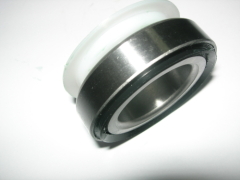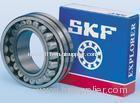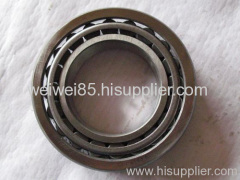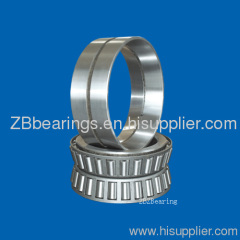
Taper roller bearings
| Payment Terms: | T/T |
|---|---|
| Place of Origin: | Liaoning |
Company Profile
| Location: | Dalian, Liaoning, China (Mainland) |
|---|---|
| Business Type: | Manufacturer, Trading Company |
Product Detail
| Means of Transport: | Ocean |
|---|---|
| Brand Name: | ZBZ |
Product Description
Tapered roller bearings are mainly suitable to carry combined load--- radial load and as well as axial load; while steep angle tapered roller bearings (27°-30°) can carry the combined load dominated by the axial load. The tapered roller bearings are separable bearings, their internal assemblies and outer rings can be mounted separately; the radial clearance and axial clearance cane be adjusted when mounting and clearance fits are also allowed.
Structures
1. 30000 type single-row tapered roller bearings
This type of bearings can accommodate the axial displacement and axial load on one direction on the shaft or housing. An additional axial force will be generated under the action of radial load, so the outer ring and inner ring inside the two bearing slewing should be mounted with their end faces with same name opposite each other. When applied separately, the applied axial force must be larger than the additional axial force.
2. 350000, 37000 and 87000 types of double-row tapered roller bearings
These types of bearings comprise one double-raceway outer ring (one double-raceway inner ring) and two inner rings (two outer rings). There is a spacer between the two inner rings (two outer rings), to change the thickness of the spacer can adjust be bearing clearance. They can carry radial and double-direction axial load simultaneously.
3. 380000 type four-row tapered roller bearings
This type of bearings adopts two double-raceway inner rings, one double-raceway outer rings and two single raceways. There are spacers between inner rings and outer rings used for adjusting bearing clearance. They can accommodate large radial load. But their limit rotational speed is low so they are mainly applied to heavy-duty machines such as rolling mills.
4. Inch tapered roller bearings
Cage materials
Tapered roller bearings generally adopt pressed steel sheet cages, when with too large sizes, use welded steel sheet cages or steel pinned solid cages.
Permissible tilt angle
Generally, inclination is not allowed between the shaft and the housing on the tapered roller bearings. If any, it should not exceed 2'.
Clearance
Users can adjust for practical clearance of the single-row tapered roller bearings according to operational demands.
Equivalent load
1. Dynamic equivalent radial load
1) Single-row tapered roller bearings:
Pr=Fr When Fa/Fr*e
Pr=0.4Fr+(0.6/e)Fa When Fa/Fr*e In the equation: Pr Dynamic equivalent radial load (N) Fr Actual radial load of the bearing (N) Fa Actual axial load of the bearing (N) e Load constant e=1.5Tan *
* Contact angle
When applying single-row tapered roller bearings in pairs, the additional axial force must be counted when computing the equivalent dynamic load of the bearings. The axial load magnitude is influenced by mounting methods and the applied axial load. The additional axial load on the single-row tapered bearings can be approximately computed with the equation below:
S=(Fr/0.8)(1.5/e)
2) Double-row tapered roller bearings:
Pr=Fr+(0.675/e)Fa When Fa/Fr*e Pr=0.67Fr+(1.005/e)Fa When Fa/Fr*e In the equation:
Pr Dynamic equivalent radial load (N)
Fr Actual radial load of the bearing (N)
Fa Actual axial load of the bearing (N)
e Load constant e=1.5Tan*
* Contact angle
2. Dynamic equivalent radial load 1) Single-row tapered roller bearings:
Por=0.5Fr+(0.33/e)Fa If Por
In the equation:
Por Dynamic equivalent radial load (N)
Fr Actual radial load of the bearing (N)
Fa Actual axial load of the bearing (N)
e Load constant e=1.5Tan*
* Contact angle
2) Double-row tapered roller bearings:
Por=Fr+(0.66/e)Fa
If Por
In the equation:
Por Static equivalent radial load (N)
Fr Actual radial load of the bearing (N)
Fa Actual axial load of the bearing (N)
* Contact angle
Minimum radial load
In order to prevent damaging sliding generated between the rollers and raceway, a minimum radial load must be acted on the bearing. The calculating formula is: Frmin=0.02Cr In the equation: Frmin Minimum radial load Cr Basic dynamic radial load rating
Operating temperature
-20*+120* When the operating temperature exceeds +120*, please contact with Technical Department
Safety coefficient
The allowable equivalent static load of a bearing depends on the basic static load rating of the bearing. While permanent deformation quantity said above (local depressed quantity) decides bearing performance and service conditions. So, safety coefficient is made out for analyzing the safety degree of the basic static load rating.
So=Cor/Pormax In the equation:
Pormax The maximum static equivalent radial load permitted to be acted
on the bearing (N) Cor Basic static radial load rating (N) So See Table 1 for Operational safety coefficient
Table l Operational safety coefficient


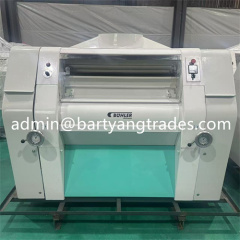
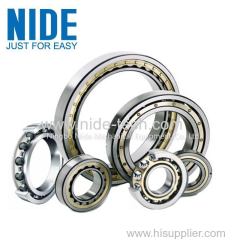
.jpg)
